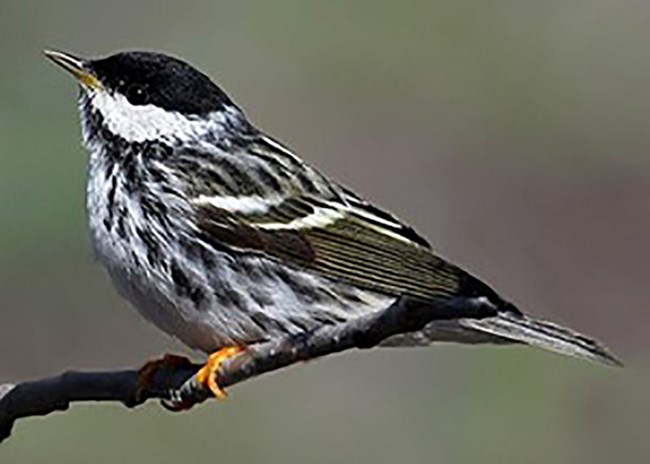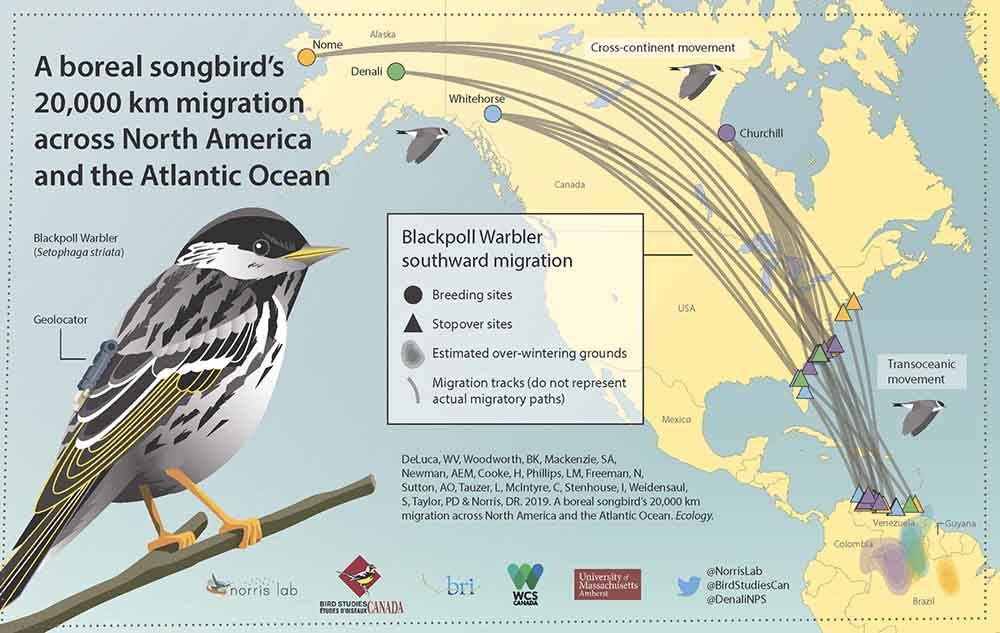Last updated: October 26, 2021
Article
Blackpoll Warbler Migration

Blackpoll Warblers take an incredible migratory journey each fall. They travel from Denali National Park and Preserve to South America, often flying nonstop for over 72 hours. Blackpoll warbler migration is monitored through the park's Critical Connections program, which uses tiny geolocator tracking devises to learn more about species migration paths.
Blackpoll Warblers breed in boreal forests and can be found in Denali in the late spring, summer, and early fall. Learning more about their migrations, the routes, phenology, and timing of their flights helps us understand the demands on the population and the ecological and physiological constraints.

UMass Amherst / University of Guelph, published in Science News on March 19, 2019.
Check out more images of Blackpoll Warblers at:
A boreal songbird's 20,000 km migration across North America and the Atlantic Ocean
Abstract
Migration is one of the most fascinating natural history events on the planet, and our understanding of these seasonal movements continues to rapidly increase with the advancement of tracking technology. For the 12-gram Blackpoll Warbler (Setophaga striata), the ability to follow year‐round movement is essential given that they are one of the fastest declining songbirds in North America. Although the study of Blackpoll migration has a long history and their non‐stop flight over the Atlantic Ocean is often highlighted as a flagship example of remarkable songbird migrations, much of this history has been anecdotal or based on indirect evidence. Using small geolocator tracking devices, researchers documented Blackpolls from breeding populations in the Maritimes and New England, at the southeastern margins of their range, depart from the northeast Atlantic coast and embark on a nonstop transoceanic flight of up to three days and 2,770 km on their way to overwintering grounds in South America. Yet, because their breeding range spans the entirety of North America's boreal forest, questions remain about the migration of Blackpolls from central and western breeding populations. Specifically, how does the phenology, duration, and routes of southward and northward migration vary geographically and do central‐ and western‐breeding Blackpolls undertake similar overwater flights to eastern‐breeding birds? Answers to these lingering questions can contribute vital natural history information for this declining species and provide insight into the physiological and ecological constraints that may limit extreme migration strategies.
DeLuca, W. V., B. K. Woodworth, S. A. Mackenzie, A. E. M. Newman, H. A. Cooke, L. M. Phillips, N. E. Freeman, A. O. Sutton, L. Tauzer, C. McIntyre, I. J. Stenhouse, S. Weidensaul, P. D. Taylor, and D. R. Norris. 2019. A boreal songbird’s 20,000 km migration across North America and the Atlantic Ocean. Ecology 00(00):e02651. 10.1002/ecy.2651
